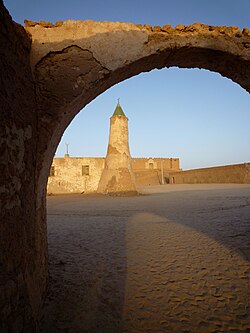Murzuk
|
Murzuk مرزق |
|
|---|---|
| Town | |

Fort and mosque of Murzuk
|
|
| Location in Libya | |
| Coordinates: 25°54′49″N 13°55′01″E / 25.91361°N 13.91694°E | |
| Country |
|
| Region | Fezzan |
| District | Murzuq |
| Elevation | 1,486 ft (453 m) |
| Population (2011) | |
| • Total | 12,746 |
| Time zone | EET (UTC+2) |
Murzuk or Murzuq (Arabic: مرزق) is an oasis town and the capital of the Murzuq District in the Fezzan region of southwest Libya. It lies on the northern edge of the Murzuq Desert, an extremely arid region of ergs or great sand dunes which is part of the greater Sahara Desert.
Murzuk developed around an oasis which served as a stop on the north-south trade route across the Sahara Desert. From the 5th century BC to the 5th century AD, Marzuk was home to the Garamantian Empire, a city state which operated the Trans-Saharan trade routes between the Carthaginians—and later the Roman Empire—and the Sahelian states of West and Central Africa. By 1300, the area was ruled by the Kanem Empire. According to Helmuth Kanter, a Moroccan tribe overran the area in 1310 and established Murzuk as the capital of their sultanate. The fortress, now in ruins, was built around this time. By 1400 the city was ruled by the Bornu Empire, and the legacy of Kanem-Bornu sovereignty is still evident, as some streets have names in the Kanembu and Kanuri languages. In the later half of the 15th century, the area became a tributary of the Hafsid dynasty in Tunis. Early in the 16th century, Muhammad al-Fasi established the Awlad Muhammad dynasty of Murzuq, which would hold power in the city until 1812. Al-Fasi is traditionally held to be a Moroccan sharif, but according to John Ralph Willis, oral tradition indicates that he was a pilgrim from Saqiyat al-Hamra in Mauritania. According to this tradition, he was the leader of a caravan who, on arriving at the fortress of Murzuk, was asked to take control of the city by local Fezzani rulers. The reason suggested for this is an intensification of Tuareg or Berber raids, or that he was attracted by slave trade. According to tradition, he built a castle in Murzuk, which has been identified possibly as the ruined "Qal'at Awlad Muhammad". The establishment of his dynasty reinvigorated pilgrim traffic and the slave trade, and soon, Murzuk became an important part of a slaving network which extended into present-day Chad and Central African Republic. By the late 16th century it had gained more importance than Ghat and Ghadames.
...
Wikipedia

